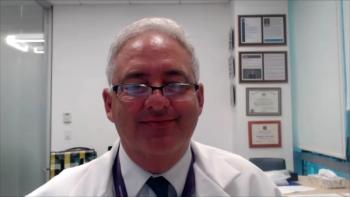
Supplements and Featured Publications
- Advancing Individualized Care Approaches for Dry Eye Disease
Evolving Payer Strategies for Personalized Dry Eye Disease Management
A Q&A With Ryan Haumschild, PharmD, MS, MBA, CPEL
Interview has been edited for readability.
AJMC®: How much do you consider treatment guidelines—such as from the American Academy of Ophthalmology, the American Society of Cataract and Refractive Surgery, or the Tear Film and Ocular Surface Society Dry Eye Workshop—when building formulary and health care institution policies for dry eye disease (DED)?
Haumschild: When developing formulary and health care institution policies, one of our top priorities is to gather and evaluate high-quality evidence. We rely on input from our disease state working groups, which include both subspecialists in eye care and general practitioners—those directly involved in treatment decisions.
In addition to clinical input, we incorporate guidelines from leading organizations such as the American Academy of Ophthalmology, the American Society of Cataract and Refractive Surgery, and the Tear Film and Ocular Surface Society’s Dry Eye Workshop. These guidelines provide a critical layer of evidence that helps shape our decision-making, particularly as we consider how to align our formularies with frontline therapies. For example, we often prioritize artificial tears and then move to prescription anti-inflammatory agents before considering more advanced medications.
We also recognize that these organizations offer both broad ophthalmology guidance and more specific subspecialty recommendations, such as those from cornea specialists. This allows us to refine general recommendations into more targeted, actionable policies.
Another important consideration is the evolving nature of coverage and evidence. While we strive to stay on-label, we understand that emerging therapies may lead or lag behind formal guideline updates. In such cases, we assess the supporting literature and, when appropriate, reference guideline support—even for therapies not yet FDA-approved—if the clinical data are compelling. We also actively engage with these societies, including at their annual meetings, to stay aligned with the most current evidence.
Ultimately, guideline-driven care is a clinical foundation for our formulary decisions. But we also balance that with internal stakeholder input to create more tailored and practical recommendations. Payers and providers alike look to guidelines as a trusted reference. By staying responsive to both evolving evidence and real-world needs, we aim to support access, affordability, and better outcomes across our network.
AJMC: How do you balance securing cost-effective treatments with ensuring coverage for therapies that address the various pathophysiological mechanisms of DED (ie, evaporative dry eye [EDE], aqueous-deficient dry eye [ADDE], or mixed etiology)?
Haumschild: It’s important to recognize that not all DED is the same. We want to maximize outcomes but also have to be cognizant of the cost—to the health plan, to the patient, to the organization—when we’re prescribing these therapies. Balancing cost-effective treatments while ensuring a comprehensive coverage and treatment approach to DED is something that involves performing a clinical review of efficacy, leveraging real-world evidence when appropriate, and keeping financial sustainability in mind.
Given that DED has multiple pathophysiological subtypes, as we’ve talked about—aqueous-deficient, evaporative, and mixed—we need to make sure that our formularies do carry on some of that structure and some of that specificity so that, again, we can optimize patient outcomes and also manage costs. Because if we use something that’s less expensive but isn’t specific to a subtype, we might miss the outcome or [improvement of that patient’s life]. I think that there’s also a cost [there]. So, I think, in totality, cost-effectiveness makes us recognize that there are different types of DED, and there’s not a one-size-fits-all approach.
It’s [important to make] sure that we understand that patients might have to go through different lines of therapy. In other words, a patient might start on a broad spectrum lubricant therapy, whether it be artificial tears or use of warm compresses. But if they’re not getting that sustained progress, then we need to—especially for a patient [with ADDE]—maybe go to a cyclosporine or maybe a nasal tear stimulator. And then if we’re looking at [EDE, there are] other therapies, such as a thermal pulsation. Or if we’re looking at mixed DED…it might be a combination of anti-inflammatory agents or lipid-based lubricants.
And so that’s important, because we also want to recognize that cost-effective care sometimes might involve a little bit more of an expensive up-front therapy that’s specific to a patient but that might lead to a reduction in total cost of care (such as for office visits), [fewer emergency department] visits, or less progression of disease over time. So that’s really where I think the cost-effectiveness comes into play—balancing the efficacy and the cost and making sure, too, that there is appropriate coverage and appropriate access to these therapies when needed. And I think, ultimately, that is truly cost-effectiveness when we think about it from a payer and provider standpoint.
So if I had to summarize some of the comments here, [it would be to] make sure that we’re providing cost-
effective treatments, but that doesn’t [mean] one-size-fits-all. It means that we’re recognizing the subtypes, and we have treatments outlined and sequenced there appropriately. We are leveraging real-world evidence, because there might be some existing therapies on the market that provide good treatment to these patients. And how do we make sure that we’re able to incorporate that in our decisions? And then recognize, again, collaboration—that if we run into barriers, we want to make sure people recognize that sometimes cost up front creates more value in the long run. And how do we make sure that that cost-effectiveness is something that we’re evaluating with high-cost therapies as well as low-cost therapies when adopting institutional formularies and ultimately designing treatment pathways?
AJMC: How does your organization identify and address the needs of different subpopulations of patients with DED? And what data do you use to understand the distribution of etiologies within your patient population?
Haumschild: As we’ve discussed, not all DED is the same. It’s a complex condition with diverse subpopulations—something that even some eye care professionals may not fully appreciate. Patients may present with autoimmune-related DED, meibomian gland dysfunction, postsurgical ocular surface disease, or medication-induced DED. Each of these etiologies carries distinct treatment needs.
To identify and address these needs, we first rely on screening tools and differential diagnosis during referral, including responses to validated questionnaires. But at a system level, one of the most powerful strategies is leveraging the electronic health record (EHR). Within an integrated delivery network, EHR data can surface patterns across patient populations—such as medication histories linked to DED, diagnoses like Sjogren syndrome, or contact lens use. These data enable more targeted, evidence-based treatment decisions.
Understanding these patient subtypes helps us tailor therapy. For instance, patients with immune-driven disease may benefit from anti-inflammatory agents, while those with EDE may require lipid-based tear substitutes over standard artificial tears. This individualized approach improves outcomes and reduces unnecessary utilization.
Collaboration across disciplines is also essential. Coordination between optometrists, ophthalmologists, and pharmacists ensures aligned treatment plans and more equitable care delivery. It’s about creating synergy across the care continuum.
AJMC: Different formularies may have varying coverage patterns for tear stimulators versus treatments for EDE. What factors drive these coverage decisions?
Haumschild: It’s interesting how formularies vary in their coverage of therapies for DED, especially when we’re treating the same patient population. There’s often a disconnect—some therapies for ADDE get coverage while treatments for EDE may not, even though both are clinically relevant.
One key factor is the strength of the clinical evidence. Payers and providers need to prioritize therapies backed by strong clinical trial data that align with specific patient needs. FDA-approved treatments for DED tend to receive more consistent coverage compared to off-label options. That said, off-label therapies with solid real-world evidence still play a role, and figuring out how to leverage that evidence is important.
Cost is another major driver. High-cost therapies that don’t show a clear return on investment from the payer’s perspective often face more barriers like step edits or restrictive prior authorizations (PAs). In some cases, payers may not receive the rebate levels they expect, which can also influence formulary placement and access requirements. Tear stimulators are a good example. They may fall under either the pharmacy or medical benefit, but their broader use in DED is often restricted. That leads to more denials, appeals, and administrative hurdles. On the other hand, when we look at therapies for EDE, coverage can depend on whether the payer recognizes lipid deficiency as a primary driver of disease. That’s not always the case, and it can create another layer of access challenges. Sometimes, providers have to justify the diagnosis in the PA just to get the patient the right therapy.
So, overall, coverage decisions are being shaped by a mix of clinical evidence, cost considerations, rebate dynamics, and whether the payer’s policy captures the nuance of different DED subtypes.
AJMC: How do current coverage policies align with evidence suggesting that treatment should be matched to the underlying pathophysiology of DED?
Haumschild: I think that there’s opportunity for improvement from a provider standpoint and a payer standpoint, because we want to make sure that coverage policies do align with the evidence, and evidence is generated all the time from guideline-based therapies, from real-world evidence, [and from] consensus statements. And so we need to understand how those coverage determinations continue to evolve with the body of evidence.
We need to make sure that if I’m thinking about, for example, EDE as part of DED, that we know that there’s more evidence now to show that those patients respond better to lipid-based artificial tears [or] omega-3 supplementation, while those with ADDE, which is another subtype we talked about, may require tear stimulators, cyclosporine, and serum tears. And so how do we get the policy to be more specific there and reduce the barriers of a patient having [failure of] a serum tear when, in reality, they needed a lipid-based tear from the get-go? I think those are some of the barriers and coverage gaps that I see. We also know that there are payer-imposed step therapies, and payers are trying to manage a benefit as best they can. So many formularies require patients to try artificial tears first, even if [it isn’t the most appropriate treatment for] that pathophysiology we just discussed.…and what we don’t want is to try a cheaper, more cost-effective artificial tear that’s aqueous-based when they should have had lipid-based [supplementation] all along, and now their cost of care and their disease progression continues to evolve.
So, when I’m thinking about DED specifically, the underlying pathophysiology, when I think about aqueous deficiency—and that could be Sjogren [disease] or post-refractive surgery—those patients really do need tear stimulators. They [may] need cyclosporine, but the [barrier] we’ll see is there’s limited coverage for tear stimulators outside of Sjogren [disease] diagnosis or that there may be higher co-pays for cyclosporine. When I think about EDE, [affected] patients might [benefit from] that lipid-based tear or intense pulsed light therapy, but they might have to start with aqueous tears, because over-the-counter or lipid-based tears are not covered. And then I think they’re getting into even more detail about neurotrophic keratitis and the different therapies that are needed there, and a lot of those are strict prioritization.
Support for these therapies should be evidence-based and guideline-driven, which involves making sure the therapy matches the DED subtype, reducing unnecessary steps to get the patients on the right therapy sooner.
AJMC: What are the cost implications when patients switch treatments due to inadequate response?
Haumschild: Across the board—whether in DED or other conditions—treatment switching due to inadequate response rather than disease progression tends to drive up the overall cost of care. In DED specifically, switching therapies has financial implications for the patient, the institution, and the payer.
These costs stem from several areas: increased medication expenses, additional clinical visits to reassess and revise treatment plans, and, in some cases, accelerated disease progression requiring more advanced interventions. A patient may start with a low-cost, over-the-counter artificial tear. If it’s ineffective, they often transition to prescription agents like cyclosporine, which represent a tenfold cost increase. Some may face step-therapy requirements, trialing multiple lower-cost options before accessing the treatment they actually need. For those who require a lipid-based therapy early on, delays in reaching the appropriate treatment can lead to disease progression—and accumulating costs.
Newer therapies like tear stimulators add another layer of complexity. Access may be restricted to specific subgroups, such as patients with autoimmune-related DED, forcing others to pursue off-label options or navigate lengthy appeals. In more severe cases, patients may need serum tears, which come with significant out-of-pocket costs.
So, when there’s a mismatch—when the patient isn’t receiving the right therapy early on—the costs ripple outward: more frequent health care visits, increased utilization, specialist referrals, and potentially even surgical intervention. The question becomes whether the patient is truly unresponsive to evidence-based care or is being cycled through generalized treatment steps that don’t reflect the specific etiology of their disease. Addressing that gap to ensure patients receive targeted, effective therapy earlier on can help reduce both clinical burden and overall cost of care.
AJMC: How do you evaluate the clinical and economic outcomes of these different approaches to DED management within your patient population?
Haumschild: Every institution needs to go beyond clinical trial data and evaluate outcomes within their own patient population. It’s one thing to know what the evidence says in general…but are we seeing those same outcomes in our covered lives? Are we truly meeting the needs of our patients?
Evaluating both clinical and economic outcomes for DED requires a real-world, patient-specific approach. That includes analyzing subtypes of DED where possible and asking key questions, like, ‘What is the patient’s time to appropriate treatment? What’s the financial burden or toxicity? What is the duration of therapy, and are we seeing meaningful clinical outcomes?’
Objective diagnostics play a critical role. Tear osmolarity and staining can help track disease progression and treatment response over time. Capturing and documenting these metrics provides actionable data. Patient-reported outcomes also are valuable. While they may not drive formulary decisions on their own, tools like the Ocular Surface Disease Index or symptom severity scores—especially if integrated into the EHR—can give insight into quality of life improvements. Adherence data, such as proportion of days covered, can help assess how consistently patients are accessing and using their treatments.
Switching patterns matter, too. How often are patients cycling through therapies? Is this driving cost? We conduct cost analyses to understand what’s truly contributing to overall spending, whether that includes pharmacy costs, medical costs, or health care resource utilization. In some cases, indirect costs may be relevant as well.
Tracking this comprehensive data helps maintain a clear pulse on outcomes and cost drivers. It also creates an evidence base to justify access to therapies—especially when appealing denials or negotiating coverage—with both clinical and economic arguments aligned. I think when you have both, that tells more of a comprehensive story.
AJMC: What barriers exist in current diagnostic coding systems for DED (eg, lack of specific International Statistical Classification of Diseases, Tenth Revision (ICD-10) codes for aqueous-deficient vs evaporative disease), and how does this impact treatment selection and disease tracking?
Haumschild: Gaps in diagnostic coding for DED create significant challenges both at the provider level and from a payer perspective. Current ICD-10 codes lack the specificity needed to distinguish between key subtypes like ADDE and EDE. That lack of granularity limits our ability to stratify patients, apply appropriate treatment pathways, and monitor disease progression over time.
For providers, this presents barriers when assigning patients to the correct clinical order sets or initiating subtype-specific therapies. For payers, it complicates efforts to design step-therapy protocols or assess utilization patterns. For example, without a specific code for EDE, it’s difficult to justify early access to lipid-based treatments without first requiring step-through of aqueous-based artificial tears, even when they are not clinically appropriate.
Similarly, access to tear stimulators may be limited to patients with an autoimmune diagnosis like Sjogren syndrome, excluding those with non-Sjogren ADDE due to the lack of clear coding. These limitations can delay appropriate treatment and contribute to suboptimal outcomes.
From a population health standpoint, the absence of detailed coding restricts our ability to conduct longitudinal analyses or support value-based care models. Risk stratification tools within the EHR often rely on diagnosis codes. Without subtype differentiation, we lose precision in both care delivery and outcomes tracking.
AJMC: What evidence gaps need to be addressed to support more personalized treatment selection and inform coverage decisions for DED?
Haumschild: First, we probably need to improve our coding, which we’ve talked about a little bit there, but I think that’s going to drive the stratification in use for individualized treatment selection. I think, too, there probably needs to be more biomarker-driven therapy [to] help with [treatment selection] as well, because if a payer [or] a provider have a biomarker that they can utilize, it gives that specificity that we’re looking for and that sensitivity to really feel confident in our treatment-related approaches. And then I think [in] most clinical trials, if you look at them, some patients with DED are grouped together to make the number needed to treat rather than segmenting by, maybe, ADDE versus EDE, as an example.
How do we help payers recognize…that some of the steps they have in place are impeding care or best practice in care? And how do we make sure they have the right information from the provider to ultimately make those decisions? What are the steps for? Because that’s really what we want to solve. Well, let’s conduct some real-world evidence studies that involve biomarkers, so whether we’re using osmolarity or something else that can stand out for a patient and a payer, they can make more confident [decisions] and understand the data. How can we use, maybe, patient subtype classification when there’s no ICD-10 code to differentiate these patients as well? I think those are things that are going to be huge.
And then in the future, if possible, can we have more cross-trial comparisons or match-adjusted indirect comparisons to provide cost-effectiveness data? That way, a payer understands if I’m providing a lipid-based therapy early on for one of these patients, I’m actually going to reduce total cost of care throughout that continuum of care. I think that’s probably going to help us improve…early versus delayed intervention, disease progression, health care costs, and quality of cost. In summary, let’s do some of these cross-specialty studies with specific patient types under DED, look at outcomes and cost, and really develop these models for appropriate visualization into the patient care continuum.
AJMC: What strategies could payers implement to support individualized treatment selection while still managing costs effectively?
Haumschild: Strategies to support individualized treatment selection while managing costs are becoming increasingly important. Payers want to do the right thing clinically, but they also need to be cost-conscious and ensure appropriate care pathways.
One key strategy is better balancing of cost control with individualized patient needs. This starts with leveraging existing evidence-based guidelines, engaging in proactive formulary reviews, and incorporating feedback from network providers or subspecialists—perhaps through a Delphi approach—to define standards of care that reflect real-world clinical nuance.
Payers also may benefit from re-evaluating current policies and recognizing that not all patients with DED should follow the same treatment path. Some patients may do well with step therapy—starting with artificial tears or cyclosporine before progressing. Others, especially those with EDE, may require lipid-based therapies earlier on. Similarly, patients with ADDE might benefit from earlier access to tear stimulators. Aligning formularies with diagnostic subtypes is a critical opportunity to close these gaps.
Another strategy is integrating validated diagnostic tools, like tear osmolarity testing, into coverage policies. These tools can support more precise treatment matching and offer a basis for policy renewals or PA adjustments. For plans seeking additional risk management, value-based agreements could be an option, allowing payers to reward improved outcomes while minimizing exposure. But regardless of contracting strategy, timely access remains crucial. Delayed treatment increases the risk of disease progression and ocular surface damage. Therefore, PA policies should be intentional, focused on stewardship, but not at the cost of avoidable delays or higher treatment failure rates.
Fast-track PAs might be appropriate for patients with clearly documented DED subtypes, particularly when supported by biomarker or diagnostic confirmation. For high-risk populations—such as those with Sjogren syndrome—consider whether PAs are necessary at all or if a streamlined process would better support timely care.
In short, payers looking to close gaps while maintaining cost stewardship should:
- Align formularies with DED subtypes based on pathophysiology
- Evaluate coverage for diagnostic tools like osmolarity testing
- Streamline PA processes to avoid delays
- Ensure access to subspecialists for accurate diagnosis and management
These actions can not only improve patient outcomes but can also optimize resource utilization and long-term value.
Articles in this issue
Newsletter
Stay ahead of policy, cost, and value—subscribe to AJMC for expert insights at the intersection of clinical care and health economics.














































